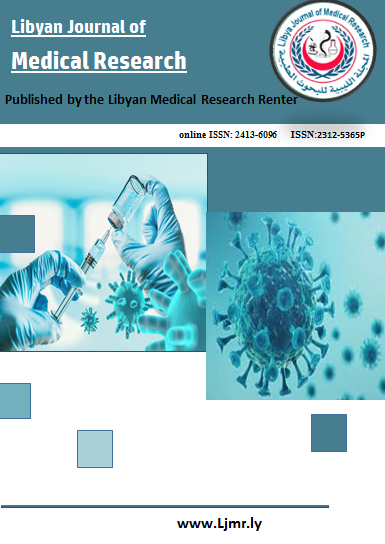Relationships between Tsawa's prevalence of chronic kidney disease and water quality indicators
DOI:
https://doi.org/10.54361/LJMR.19.1.28Keywords:
water, CKD, heavy metals, bacterial contamination, Tsawa, LibyaAbstract
Background AND AIM: This study investigates the correlation between the prevalence of chronic kidney disease (CKD) and water quality indicators in Tsawa, a city in southern Libya. Given the essential role of water quality in kidney health, this research aims to identify potential environmental risk factors contributing to CKD in the region. Materials and Methods : Twenty-four groundwater samples were collected from various wells across Tsawa. Each sample underwent biochemical analysis to assess total dissolved solids (TDS) levels and microbiological testing for bacterial contamination, specifically Escherichia coli. Additionally, concentrations of heavy metals, including lead (Pb), cadmium (Cd), and iron (Fe), were measured. Demographic data were gathered through questionnaires to determine water consumption patterns among residents. Results and Discussion: The findings revealed that 20 out of 24 wells had TDS levels within the World Health Organization's (WHO) recommended limits for drinking water. However, one well exhibited a significantly high TDS level, exceeding 1300 mg/L. Microbiological analysis indicated the presence of E. coli in four wells, with low colony counts (3–6 CFU/100mL). Notably, heavy metals were undetectable in all samples. Survey data indicated that approximately 65% of residents consume well water, with 58% drinking 1–2 liters daily. Despite the presence of certain water quality issues, statistical analysis revealed a weak correlation between water quality indicators and CKD prevalence in Tsawa. These results suggest that while water quality may influence kidney health, other factors such as dietary habits, genetic predispositions, and healthcare access might play more significant roles in the development of CKD in this region. Conclusion: while water quality monitoring remains crucial, multifactorial approaches are necessary to comprehensively address CKD prevalence in Tsawa. Further research is recommended to explore other potential environmental and lifestyle factors contributing to CKD in southern Libya.
Downloads
References
1 . Tchounwou, P. B., et al. (2012). "Lead and Kidney Function: Impact of Chronic Exposure." Environmental Toxicology.
2. Smith, A. H., et al. (2006). "Arsenic Exposure and Kidney Disease: A Review of the Evidence." American Journal of Kidney Diseases.
3 . Ravichandran, P., et al. (2014). "Mercury Toxicity and Its Effect on Renal Function." Toxicology Reports.
4. Hussain, S., et al. (2013). "Impact of Microbial Contamination of Water on Kidney Infections." Journal of Infectious Diseases.
5. Farahat, F. M., et al. (2014). "Pesticide Exposure and Renal Damage." Environmental Health Perspectives.
6. Chinoy, N. J., & Patel, T. J. (2000). "Effect of Fluoride on Renal Function." Environmental Toxicology
7. Brhane, G.K. Characterization of hydro chemistry and groundwater quality evaluation for drinking purpose in Adigrat area,Tigray, northern. TITLE Water Sci. 2018, 2017. [CrossRef]
8. Nas, B.; Berktay, A. Groundwater quality mapping in urban groundwater using GIS. Environ. Monit. Assess. 2008,
160, 215–22[CrossRef]
9. Akinbile, C.O.; Yusoff, M.S. Environmental impact of leachate pollution on groundwater supplies in Akure, Nigeria. IJESD
2011. [CrossRef]
Processes 2021, 9, 154 29 of 31
10. Alfaifi, H.J.; Kahal, A.Y.; Abdelrahman, K.; Zaidi, F.K.; Albassam, A.; Lashin, A. Assessment of groundwater quality in Southern
Saudi Arabia: Case study of Najran area. Arab. J. Geosci. 2020, 13, 1–15. [CrossRef]
11. Dzwairo, B.; Hoko, Z.; Love, D.; Guzha, E. Assessment of the impacts of pit latrines on groundwater quality in rural areas: A case
study from Marondera district, Zimbabwe. Phys. Chem. Earth 2006, 31, 779–788. [CrossRef]
12. Qaseem, N.M.A.; Al-Barwary, M.R.A. Evaluation of physical and chemical quality of well water in Zakho District, Kurdistan
region, Iraq Evaluation of physical and chemical quality of well water in Zakho District, Kurdistan region. Iraq. IOP Conf.
2018. [CrossRef]
13. Mahmood, K.; Kamal, A.A.; Hama, A.R. Study and evaluation of stored drinking water characteristics using three types of roof
water tanks in Kirkuk Governorate, Iraq. WJES 2018, 11–16. [CrossRef]
14. Gopinath, G.; Laluraj, C.M. Assessment on seasonal variation of groundwater. Environ. Monit. Assess. 2006, 45–57. [CrossRef]
15. El-salam, M.M.A.; Abu-zuid, G.I. Impact of landfill leachate on the groundwater quality: A case study in Egypt. J. Adv. Res.
2014. [CrossRef]
Downloads
Published
Issue
Section
License
Copyright (c) 2025 Osama H ALmjdoub, Abdusalam M. Abdull, Ali Abd Alahrash, Khaled Aburas, Hajer Rashed, Asmahan Abukhdir, Nasrin Elfarrah, Salah Bahron, Amna .y. farhat , Souad .M. Kshed (Author)

This work is licensed under a Creative Commons Attribution-NonCommercial-NoDerivatives 4.0 International License.
Open Access Policy
Libyan journal of medical Research (LJMR).is an open journal, therefore there are no fees required for downloading any publication from the journal website by authors, readers, and institution.
The journal applies the license of CC BY (a Creative Commons Attribution 4.0 International license). This license allows authors to keep ownership f the copyright of their papers. But this license permits any user to download , print out, extract, reuse, archive, and distribute the article, so long as appropriate credit is given to the authors and the source of the work.
The license ensures that the article will be available as widely as possible and that the article can be included in any scientific archive.
Editorial Policy
The publication of an article in a peer reviewed journal is an essential model for Libyan journal of medical Research (LJMR). It is necessary to agree upon standards of expected ethical behavior for all parties involved in the act of publishing: the author, the journal editorial, the peer reviewer and the publisher.
Any manuscript or substantial parts of it, submitted to the journal must not be under consideration by any other journal. In general, the manuscript should not have already been published in any journal or other citable form, although it may have been deposited on a preprint server. Authors are required to ensure that no material submitted as part of a manuscript infringes existing copyrights, or the rights of a third party.
Authorship Policy
The manuscript authorship should be limited to those who have made a significant contribution and intellectual input to the research submitted to the journal, including design, performance, interpretation of the reported study, and writing the manuscript. All those who have made significant contributions should be listed as co-authors.
Others who have participated in certain substantive aspects of the manuscript but without intellectual input should only be recognized in the acknowledgements section of the manuscript. Also, one of the authors should be selected as the corresponding author to communicate with the journal and approve the final version of the manuscript for publication in the LJMR.
Peer-review Policy
- All the manuscripts submitted to LJMR will be subjected to the double-blinded peer-review process;
- The manuscript will be reviewed by two suitable experts in the respective subject area.
- Reports of all the reviewers will be considered while deciding on acceptance/revision or rejection of a manuscript.
- Editor-In-Chief will make the final decision, based on the reviewer’s comments.
- Editor-In-Chief can ask one or more advisory board members for their suggestions upon a manuscript, before making the final decision.
- Associate editor and review editors provide administrative support to maintain the integrity of the peer-review process.
- In case, authors challenge the editor’s negative decision with suitable arguments, the manuscript can be sent to one more reviewer and the final decision will be made based upon his recommendations.














